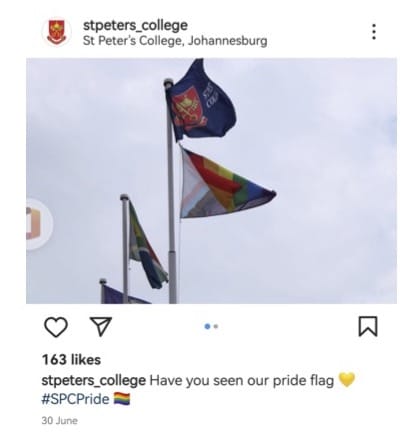It goes something like, “If you question flying the Pride flag at any school, in any way, at any time, you’re a homophobe”. Usually on Twitter. But then there is reality.
Several private schools in South Africa have drawn ire and accolades (but mostly indifference) for flying the Pride flag alongside the school flag and the national banner.

The argument in favour of this gesture is clear. Pupils should all feel welcome, regardless of sexual preferences. That is a necessary and noble intention. We would need to fight anyone who challenged that. I just don’t know anyone who does.
Proponents, however, take several leaps from there. Here are the three chief ones I’m seeing. Flying the Pride flag at schools is:
- Always and everywhere without any cost;
- Entirely inclusive; and
- Necessary to achieve inclusivity.
In (1) above I mean the opportunity cost in particular. To fly the Pride flag for X amount of time in Y place means every other flag is not flown in that place at that time. As with any out-of-home advertising, prime “eyeball estate” is limited. And let’s not ignore that flying any flag replaces not flying a flag. Not flying a flag is an option. Often a darned fine one.
So, flying the Pride flag frequently and prominently is, at minimum, a refusal to give credence to other causes. It begs the question, why Pride? Why so frequently? Why positioned so that nobody misses it on arrival or departure?
Is the Pride flag’s purpose so clearly more important to youngsters than mental illness? That is, more deserving of awareness and action than every mental illness that is not given that messaging space? Should it blot out racial issues? What about poverty reduction? There are flags and logos for testicular cancer awareness and charities fighting genital mutilation. It is a heavy burden to show that the Pride flag should be raised to the exclusion of the others. Of course, that doesn’t rule out good reasons for limited, shared display. Balance.
Exclusion by “inclusion”
Assumption (2) fails scrutiny as well. The Pride flag is also exclusionary towards other imagery promoting gay rights. I’ve used Pride as a proper noun, suggesting it is a named brand. It is not the universal and only logo that presides over gay rights. It has a particular emphasis, history and subtext.
Displaying the Pride flag to the exclusion of others can be exclusionary on two counts. First, the gay pupil who doesn’t agree with the full ethos of the Pride flag is excluded. Why should she see only that manifestation of a wider movement. Second, the gay pupil who endorses the flag, but doesn’t want it displayed at the school gates is excluded. Don’t you have causes that you champion, but whose defining symbols you’d rather not pass under every day?
We can walk and chew bubble-gum, yes. That’s my point. My first task is to demonstrate that no public imagery for any valid issue should dominate the public square.
What about occasional or rare flying the Pride flag next to the school flag? I argue that a flag ought to be something that everyone who is part of the institution necessarily signs up to and does so willingly and without equivocation. It must not have political meaning.
A domestic, private institution should only fly a political/politicised flag if it intends to include only people of that political persuasion. That flag will necessarily exclude those of other political persuasions. That is a sensible thing for a political body. Nobody would ask any American Democrat to pledge allegiance underneath the Republican elephant. Or a Republican to do the same under the Democrat donkey. Any flag with political meaning is not okay for a school or sports club or temple to hoist.
Is the Pride flag political? I’d suggest yes. That is a thorny, more extensive debate than is necessary here. If one deems it political, it has no business flying above the quad.
The Pride flag certainly doesn’t represent all of the people who ought to be welcome at a school. Consider the devoutly Muslim boy. I suggest he is fully entitled to believe that homosexuality is a sin. At the same time, I’d argue that is a poor stance. I disagree and dislike it. I submit it is philosophically flawed. But I defend the right to have that stance.
Similarly, an atheist may apply her moral reasoning to conclude that being gay is somehow unethical. Again, I have only ever seen poor arguments for that. As it happens, I apply an atheist approach to conclude that sexual preference is not a moral issue at all. If it is one of the many things that make up who you are and give you meaning, embrace it. Attempts to limit that deserve unyielding resistance.
Should the Catholic girl who believes homosexuality is a sin be protected from ever seeing the Pride flag? No. Should she be forced to see it every day, hung alongside other symbols that she has signed up for? That would seem unwelcoming, exclusionary, unnecessary. Why?
Of course, a school may genuinely be exclusively of one religion. That is their right. It may be an admission criterion to share that faith. I’d not go there. But if I did, I’d entirely accept that the chosen – contracted – religion will display its symbols prominently and frequently. And how dare I complain about that?
Fit for purpose?
Part (3) seems universally taken for granted by proponents. But what makes us think that flying the Pride flag at schools makes gay pupils feel welcome? Has anyone asked them? I’m struck by a parallel with adoption of “Latinx” in Americas warped racial climate. It seems that white Americans are the inventors and only users of this term. They decided in their arts colleges that the gendered terms Latino and Latina were offensive. And they tried to cancel them. To force a new term on everyone on pain of defamatory punch-back. A form of Newspeak.
Perhaps the goal is to make other students more welcoming of gay pupils. This seems fanciful. There is no evidence that there is anything more than a small, embarrassed minority at these schools who are homophobic. If they were vocal, we’d surely have heard about it. It is unclear why quasi-ambush marketing will change their narrow minds.
So the target audience may be the kids who are still working things out, dealing with their own surging sexuality. Those who experience some mild, changing degree of bias of every sort. Who grapple with those feelings and work towards healthier positions. But who harbour nothing resembling homophobia. That is, just about every youngster, isn’t it?
If I’m wrong, and there is evidence that flying a flag will help them through this discovery process, I’m all ears. I’d suggest the real way to assist takes hard work. Difficult discussions and a level of openness that most of us find uncomfortable. If only we could solve or substantially improve real challenges by raising a flag!
Interrogating (3) in another way: Are there schools that fly the Pride flag while doing a terrible job of welcoming gay kids? And are there schools that don’t raise the flag, but are superbly welcoming to all? Yes and yes.
It’s how you use it
None of the above is to advocate that the Pride flag be banned from any appearance in any context at any school and for any age group. Quite the contrary. I’d suggest it is vital that kids engage with many important issues and movements of the day and of days gone by. At an appropriate age. In a sensible way. In a balanced way.
As a simple proposal, I’d suggest a properly credentialed person should discuss the Pride flag in life orientation classes in high schools. Not every month. And this issue and this particular branding need to share the public square. Every workshop on sexual orientation is one not spent on identifying depression early or learning proper nutrition or working out how to pay your taxes one day. It uses oxygen that is then not available for detecting abuse at home or dealing with grief or passing algebra. Balance.
The burden of proof is on those wanting to act. Why a school? Why “proper noun” Pride? Why this level of attention relative to the unending list of other important rights and movements? Why at this frequency? Why not deploy efforts on other, potentially better ways to achieve this same goal? And why with kids of the given age? Your move.
[Photo: Neo Artemis for Pixabay]
The views of the writer are not necessarily those of the Daily Friend or the IRR.
If you like what you have just read, support the Daily Friend

